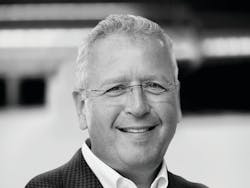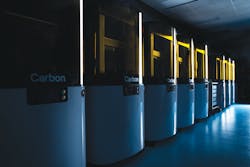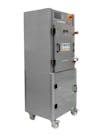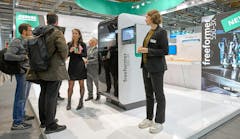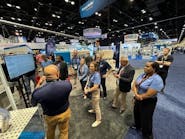A fictional character in the “Terminator 2: Judgment Day” movie inspired Dr. Joe DeSimone, 55, and other partners to co-found Carbon, a developer of additive manufacturing technologies. A few years later, their inspiration took shape in one of the company’s milestone 3-D printers, featuring the company’s Continuous Liquid Interface Production (CLIP) technology. The company also established the industry’s first subscription-based model to help customers ensure their equipment is always up-to-date. DeSimone covers this and more in an interview with Plastics Machinery Magazine senior reporter Bruce Adams.
When were you first exposed to the plastics industry?
DeSimone: When I was a graduate student at Virginia Tech, I studied under one of the best polymer scientists in the country, Jim McGrath, whose research group exposed me to polymer science. When I had my own research group, my students and I studied new ways to use carbon dioxide to make industrial processes better, including processes to make high-performance plastics like Teflon. Our work at the University of North Carolina spawned multiple licensing efforts and companies.
What led you to co-found Carbon?
DeSimone: The other founders and I were all interested in why 3-D printing hadn’t fulfilled its potential. The technology has been around since the 1980s and was primarily used as a prototyping tool instead of as a real manufacturing technology. We were inspired by the “Terminator 2” T-1000 movie character, who forms rapidly out of a puddle. We wanted to be able to mimic this — the idea that a finished part
could arise out of a pool of liquid — in an additive manufacturing technology. We use light as a chisel to do this now with the Carbon Digital Light Synthesis technology. Once we had the initial concept for the approach down, we were able to demonstrate it and move forward to launch a company based on this advance.
Do you agree that 3-D printing is a niche manufacturing method for very specific tasks within plastics manufacturing?
DeSimone: Yes and no! Traditional 3-D printing is a very niche technology for manufacturing, better for use in prototyping. However, what we do, Digital Light Synthesis, is not a niche method considering how scale-up is already working, including in areas like running shoes with Adidas. Another example is the mass-customization of dental products. Our work already includes products in automotive, aerospace, medical, dental and sports equipment. Parts made with the Carbon platform are used in Vitamix machines, for example.
How would you define “at scale” for additive manufacturing? What are the challenges?
DeSimone: The biggest challenge has been helping customers overcome their preconceived notions about additive manufacturing. We’re developing a new way of making things that requires new materials, new processes and new supply-chain models. Scale depends on the industry. In the consumer market, it could mean tens of millions of products annually; in automotive, hundreds of thousands annually.
Carbon's 3-D printersCarbonIn February, Carbon unveiled the L1. What is its significance for the company and the industry?
DeSimone: We launched the L1 around the time we announced our partnership with Riddell, the sports-equipment company. The L1 is made for immediate, high-volume production and has 10 times the build area of our first-generation printer. This helps our customers reduce print time and make more parts efficiently at scale, meaning many parts can now be printed simultaneously, and bigger parts are possible.
Our partners with high-volume production needs, like Adidas and Riddell, can now manufacture parts more quickly and efficiently. For Riddell, we created the helmet liner for their SpeedFlex Precision Diamond football helmet using the Carbon L1. These are elaborate printed structures. They contain more than 140,000 individual struts that are carefully orchestrated into patterns optimized for absorbing impact energy while at the same time providing excellent comfort and fit for players. The result is a 3-D printed, custom-fit, impact-absorbing helmet liner that advances the state-of-the-art in head protection. The Carbon L1 allowed Riddell to innovate and manufacture this product, which was used by some NFL players during the 2018 season.
The Riddell product illustrates the capability to manufacture what was previously unmakeable. Complex structures like this with so many struts arranged in very intricate ways aren’t feasible to design or produce using traditional manufacturing methods or materials. With Riddell, the design also enabled 20 discrete pieces to be consolidated to seven helmet pads. The L1 is breaking new ground by crafting intricate lattice structures in large quantities.
Explain the difference between building parts on a 3-D printer and growing parts
on a 3-D printer.
DeSimone: When we first developed our technology, we wondered if one could grow parts out of a
puddle like T-1000 in the “Terminator” movie. Could the mass of an object be derived from a source of liquid resin below it? We developed a process that does this. It uses light and oxygen to grow parts. Light triggers the solidification of the liquid resins and oxygen inhibits that. This is enabled by a breakthrough in material science that allowed us to create a window that lets both light and oxygen come through it simultaneously in an independently controllable manner. When this window is at the bottom of a reservoir of a partially UV-curable resin, we can enable the growing of parts rapidly.
This process also enables us to manufacture layerless parts. Layerless parts emerge, or grow, rapidly from a pool of liquid resin. Traditionally in 3-D printing, layer-by-layer approaches have been dominant. But that process is slow and there is often a shale-like effect where, mechanically, a part is not as strong in one direction as it is in another.
We published a paper in a top research journal, Proceedings of the National Academy of Sciences, showing how the continuous nature of the core technology behind the Carbon platform enables isotropic parts — parts with physical properties that are consistent no matter what direction
they are measured in. This is key to achieving production-quality parts. Our ability to do this is rooted in taking a chemical approach, where the interaction of light and oxygen allows for continuous printing.
What challenges did you encounter as your business grew?
DeSimone: Figuring out what our business model should be was a critical challenge. I'm proud of the outcome — the industry’s first subscription-based model that future-proofs customers from obsolescence.
What are some milestones for Carbon?
DeSimone: In 2015, I introduced CLIP (Continuous Liquid Interface Production) to the world at TED2015 and via a Science Magazine feature. In 2016, we introduced our first 3-D printer, the M1, which was the first to use Carbon’s technology delivering layerless, high-resolution parts with high-quality surface finishes. The following year, the next iteration, the M2, with twice the build volume, was introduced as part of Carbon’s SpeedCell manufacturing system alongside a Smart Part Washer that uses optimized wash protocols so that every part is cleaned consistently with minimal labor.
Our partnership with Adidas was a major turning point. We made more than 100,000 Futurecraft 4D midsoles for them last year. The debut of the L1 printer in February and the helmet deal with Riddell were highlights. In March this year, we released the industry’s first fully integrated digital manufacturing platform for dental and orthodontic labs. Also, in April, during the world’s largest dental trade show, we debuted the L1 production solution, the industry’s first end-to-end solution for high-volume production of clear aligners. In May, Adidas launched a new running shoe featuring a 4-D lattice midsole created on the Carbon platform.
Do you hold any patents? How many patents does Carbon hold?
DeSimone: I personally am an inventor on more than 250 patents during my career. Carbon has more than 240 pending patent applications and more than 70 issued patents in the United States and abroad.
What is Carbon working on now?
DeSimone: Building our advanced development facility, which will help Carbon’s engineering teams
improve the Carbon platform and workflows in scaled-up manufacturing environments. We are also working on international expansion, especially in Europe and Asia. Health care and life sciences is a big opportunity. Our goal is to help reduce health-care systems costs by thinking of new ways to treat and cure diseases and to improve patient outcomes and experiences. This means working on things like surgical tools, implants and drug delivery.
What is your impression of Industry 4.0 and its future in the plastics industry? How does additive manufacturing fit into that future?
DeSimone: Digital has transformed almost all parts of the economy, but digital fabrication technologies have been held back without the ability to scale into real manufacturing applications. The full potential of Industry 4.0 hasn’t been realized mainly because of the lack of scalable digital fabrication techniques.
In the context of Industry 4.0 and the idea of smart factories, we are finally seeing momentum with additive manufacturing technologies themselves. Traditional approaches for manufacturing polymer parts still dominate, like injection molding. It’s likely that injection molding will continue to have a place. But among other issues, molding severely limits design possibilities. So, there's a lot of room for different approaches and new technologies.
With digital fabrication that is actually scalable, which is what we're doing at Carbon, there are massive opportunities across diverse industries for integrating digital design and digital manufacturability with end-use function. Creating a complex, unmoldable design — a previously unmakeable part — is not just possible now, but it's possible to design it, and then print it at production quality in an extremely short time frame, and to do so at scale.
So, we are starting to see innovations in polymeric products that weren’t possible to make before, and also the ability of product teams to rapidly accelerate design cycles and time to market. This allows creativity and innovation to be unleashed on a new level without previous constraints, and not just to make previously unmakeable products, but to be smarter about how we make them, including to reduce the environmental repercussions of plastics.
How does diversity relate to innovation?
DeSimone: Diversity is a fundamental tenet of innovation. When building teams, factoring in human diversity and disciplinary diversity should be primary. Our original invention, which now powers the Carbon platform, relied on our perspectives and knowledge as chemists and physicists. This helps illustrate the importance of disciplinary diversity in problem-solving. Historically, 3-D printing techniques have developed from advances in mechanical engineering, but we looked at things quite differently from that standard, and we also had very different perspectives and ideas within our own team. I've found consistently in my career that the greater diversity of expertise, perspectives and experiences you have around the table, the better positioned a team is to have dynamic discussions, to challenge prevailing standards and to deliver new insights and innovations.
Diversity is a core value at Carbon. Human diversity — a diversity of human identity — is perhaps even more critical. Life experiences influence how different perspectives, worldviews and problem-solving approaches develop. Life experiences are shaped by a person's identity, by who they are fundamentally, not just what they've studied or have expertise in. This means a difference of cultures, ethnicities, gender, sexual orientation, personality and other inherent characteristics. When building a team and company, emphasizing human diversity and bringing people together who have vastly different life experiences provides a more fertile ground for innovation and success overall.
What legacy do you want to leave behind?
DeSimone: I've been lucky to be a part of brilliant teams in research and now also in business, and I hope that our inventions and our work can always be thought about as contributing to the world in a way that leaves it better than we found it.
